Derby's Heritage Part 20 - St Peter's ....
w/e 28 August 2011
All this week's pictures were taken
with a Kodak DX6490
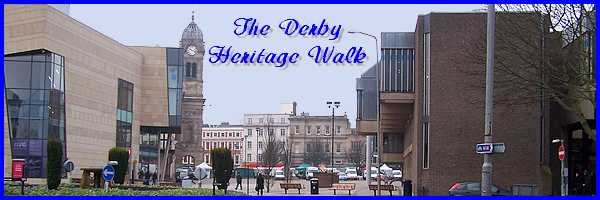
All of the images in this part have some connection
to St Peter for having crossed Victoria Street at the site of
St Peter's Bridge we continue along St Peter's Street as far
as St Peter's Church and then turn into St Peter's Churchyard.
In a later part we will return from the opposite direction to
see the rest of St Peter's Street.
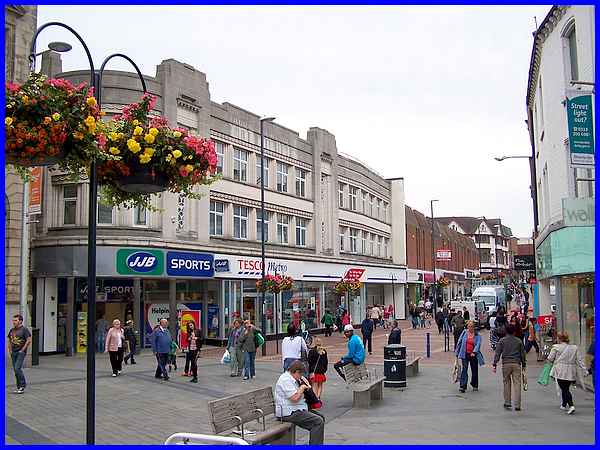
From the end of St Peter's Street, the east side displays three
distinct architectural styles. The one furthest away is on the
corner of East Street and is worthy of a much closer look which
we will do in a later part. It also marks the extent of our progress
in this part along St Peter's Street which was pedestrianised
in 1991. The more modern style of architecture of the Audley
Centre in the middle dates from the early 1970s and is a development
by Audley Properties that replaced a large Victorian building
that once housed the Midland Drapery department store. The development
incorporated a shopping arcade through to East Street but it
was never a 100% success and the opening of the Westfield Centre
appears to have finally sealed its fate although the businesses
fronting East Street and St Peter's Street are still going concerns.
The closest building was where Marks & Spencer traded until
they too moved into Westfield but like so many of our cities,
the architecture above the shop fronts is more demanding of our
attention than any of the occupants past or present.
|
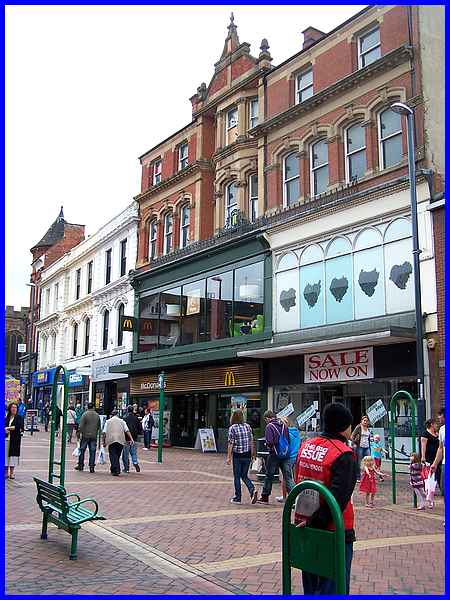
The western side of St Peter's Street has been much more successful
in retaining some of the excellent architecture from an earlier
period but again it is to the upper storeys we must look to appreciate
the features. This four storey building opposite the Audley Centre
was a rival to the Midland Drapery store it faced and traded
under the name of Thurman and Malin. It was founded in 1879 by
John Thurman and William Malin and traded as drapers, hosiers
and undertakers, and only closed as recently as 1970.
|
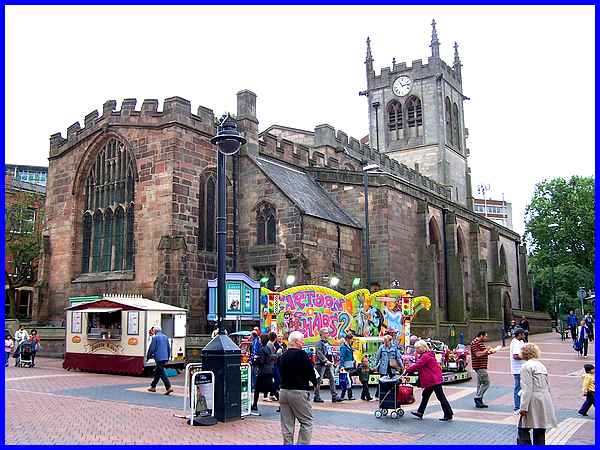
About half way along St Peter's Street a road called St Peter's
Churchyard leads off to the right and this is the route we will
follow but first a look at St Peter's Church that stands on the corner
and which was recorded here in the Domesday Book although it
has been rebuilt twice since. (Check out the History section
of the church's website for more).
|
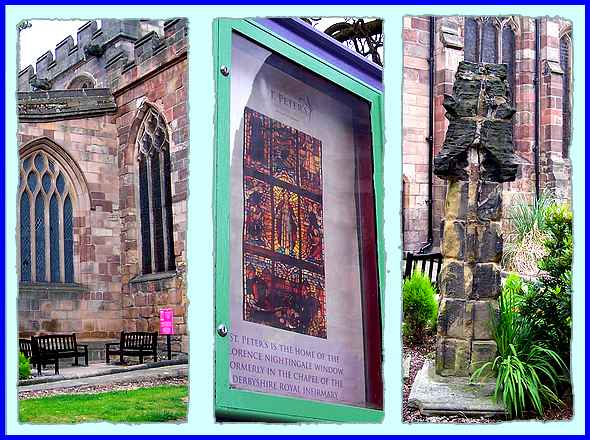
The church has the distinction of being the oldest mediaeval
church in Derby and it is recorded that during the Black Death
crisis in 1349, many bodies were buried vertically in the churchyard
to save space because of the number of victims. Today there is
a quiet area in the churchyard where people can sit and reflect
just a few steps away from the busy shopping area. A stone pinnacle
also stands near this quiet area and presumably comes from when
the tower was rebuilt in the nineteenth century. I had hoped
to gain entry to the church to photograph the Florence Nightingale
window but was foiled on two separate occasions when the doors
were locked so had to make do with the image on the notice board
outside. The window was originally installed in the Derbyshire
Royal Infirmary chapel in 1960 but was moved to the church in
2010 when the DRI closed. For more information see the Florence Nightingale Window on the church's
website and this Wikipedia entry.
|
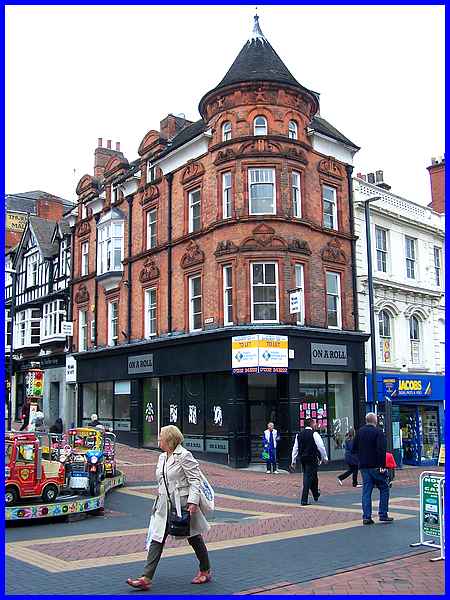
 So
leaving the church and turning into St Peter's Churchyard (left),
the first building of note stands on the corner and was built
in the 1880s. So
leaving the church and turning into St Peter's Churchyard (left),
the first building of note stands on the corner and was built
in the 1880s. 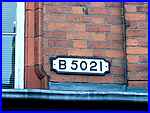 The
three storey structure with dormer windows and a projecting cornice
parapet is most noticeable for its four storey conical tower.
Although currently standing empty, Boots traded from here for
many years before moving diagonally across the road to the corner
of East Street and then on again. The
three storey structure with dormer windows and a projecting cornice
parapet is most noticeable for its four storey conical tower.
Although currently standing empty, Boots traded from here for
many years before moving diagonally across the road to the corner
of East Street and then on again.
A cast iron road sign B5021 (right) still adorns the wall similar
to the one in Victoria Street although the 1991 pedestrianisation
scheme meant an end to through traffic.
|
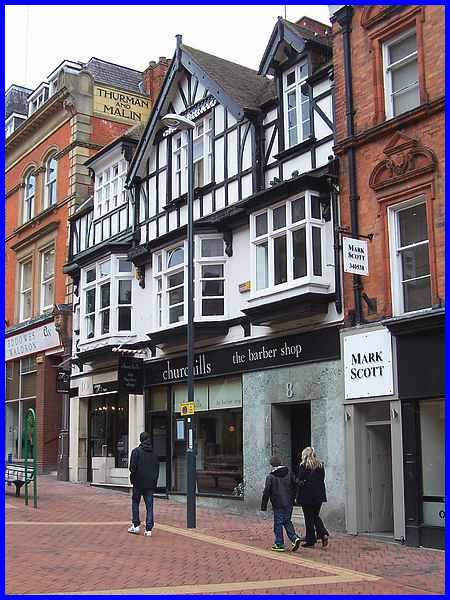
The black and white building next door does not date from the
Tudor period despite its appearance although it is well over
a hundred years old being built in 1894. Genuine or not the mock
Tudor appearance is an aesthetically pleasing addition to the
area. Also visible in this image are the aforementioned names
of Thurman and Malin on the contrasting architecture of the adjacent
building. These were additional premises built about 1900 for
the company that traded around the corner in St Peter's Street
opposite the Midland Drapery store.
|
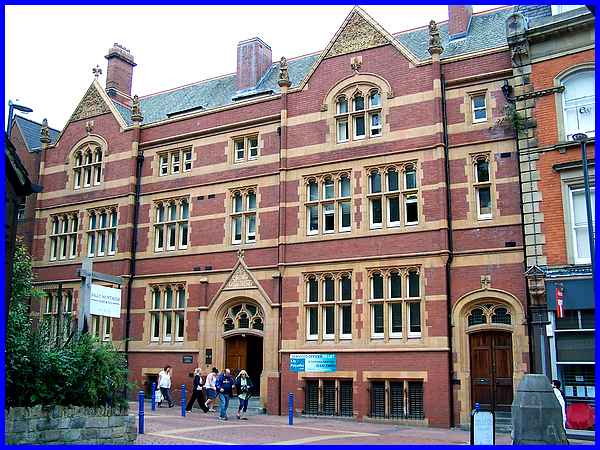
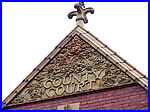 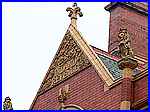 Another striking feature of St Peter's Churchyard
is the former combined County Court and Inland Revenue building
with the words being visible in the stonework (left & right)
at the top of the Grade II listed building which also sports
some fine statues. The interior was altered in 1992 to form offices
but currently the blue sign on the wall states "Serviced
Offices To Let and Conference Room Hire". Another striking feature of St Peter's Churchyard
is the former combined County Court and Inland Revenue building
with the words being visible in the stonework (left & right)
at the top of the Grade II listed building which also sports
some fine statues. The interior was altered in 1992 to form offices
but currently the blue sign on the wall states "Serviced
Offices To Let and Conference Room Hire".
|
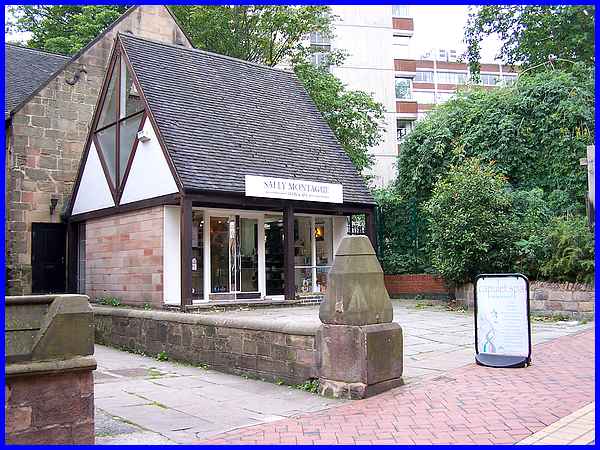
Behind the church and across from the Court/Revenue building
is the Old Grammar School which has been restored with many of
its original features retained and is now occupied by a hairdressing
salon which opened here in 2006. From 1992 however until it closed
in 2005, this was the Derby Heritage Centre, founded by Richard
Felix who was responsible for introducing the "Ghost Walks"
around what is reputed to be the most haunted city in the country.
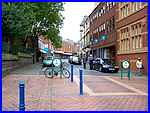 The
premises were built in 1554, when a Royal Charter was granted
by Mary Tudor and a blue plaque on the building goes on to say
"The school, universally known as Derby School, occupied
this site for over 300 years before moving to St Helen's House.
Rev. John Cotton (1585-1652) a founder of Boston, Mass. USA;
John Flamsteed F.R.S. (1646-1719) the first Astronomer Royal
and Joseph Wright A.R.A. (1734-1797) 'Wright of Derby', Painter
were taught here." It is also here in St Peter's Churchyard
that the pedestrian area ends (right) and from where we will
continue to Green Lane in the next part. The
premises were built in 1554, when a Royal Charter was granted
by Mary Tudor and a blue plaque on the building goes on to say
"The school, universally known as Derby School, occupied
this site for over 300 years before moving to St Helen's House.
Rev. John Cotton (1585-1652) a founder of Boston, Mass. USA;
John Flamsteed F.R.S. (1646-1719) the first Astronomer Royal
and Joseph Wright A.R.A. (1734-1797) 'Wright of Derby', Painter
were taught here." It is also here in St Peter's Churchyard
that the pedestrian area ends (right) and from where we will
continue to Green Lane in the next part.
|

